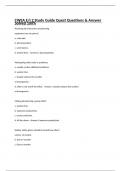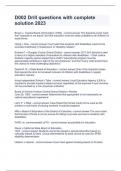TASK 6: DESIGN & ANALYSIS OF
NEUROIMAGING EXPERIMENTS
BLOCK DESIGN
Stimuli that belong together in one condition could
be grouped together
Alternation of two conditions – AB block
A cycle correspond to two epochs of each condition
Advantages: (1) more power than event-related designs,
more able to detect significant but small effects, (2)
required for studying state-based processes, (3) better
subject compliance when condition switching is disruptive, (4) easy to analyse
Disadvantages:
Impossible if we don’t know in advance how events should be grouped
Sometimes categories are defined by each participants and cannot be blocked
together beforehand
Sometimes task requires that they events unexpected & occur infrequently
Can’t estimate time-course of hemodynamic response
May promote unintended subject strategies, anticipation, habituation
Require pre-specification of a limited set of experimental comparisons
EVENT-RELATED & BEHAVIOURALLY DRIVEN DESIGN
Different stimuli / conditions could be interspersed
with each other
Different intermingled conditions are subsequently
separated out for the purpose of analysis
Advantages:
Enable much wider range of experimental designs
More closely related to typical design structure of most cognitive psychology
experiments
Can detect transient variation in haemodynamic responses, which allows temporal
characterisation of BOLD signal changes haemodynamic response function
(HRF)
Brain regions correlated to the task can have different HRF
Allows for analyses related to individual responses to trials
Provides the means to analyse neural correlates of behavioural responses
Less sensitive to head motion artifacts
Can be used to assess practice effects
Allows for randomisation of order of presented conditions
, Can vary time between stimulus presentation reducing subject’s ability to predict
when & what will happen maintains attention level across experiment
RAPID ERFMRI
Variation in which the interstimulus interval (ISI) is shorter than the duration of the HRF
generated from previous stimuli next stimulus begins, before the previous HRF is
back at its baseline
Easier to understand neural correlates of many
psychophysical experiments
Increased number of stimuli presented per time
unit enhances statistical power
FMRI responses – mixtures of several stimuli /
conditions
Can be unmixed through deconvolution
Advantages: (1) allow for random intermixing of trial types, (2) can provide estimates of
HR time-course, (3) allow for separation of HR from artifact events, (4) conditions can
be categorised post-hox, (5) possible to study unusual events, (5) designs directly
compatible with other methodologies
Limitations: (1) reduced ability to estimate HRF properties of a single stimulus, (2)
problems related to linearity vs. non-linearity of BOLD interaction, (3) reduced
statistical power, (4) unsuitable when conditions have large switching cost, (5) more
difficult to analyse
Linearity assumption – BOLD responses can be seen for each specific type of stimulus
& there is no interaction between them
2nd limitation: stimuli are faster than BOLD signal can be shown BOLD signals of
different stimuli overlap BUT during data analysis we can separate the BOLD
signals of each stimulus from the next one
Slow fMRI – just the normal fMRI
MIXED DESIGNS
Combination of block & event-related designs
Can provide information relating to maintained vs. transient neural activity during
paradigm performance
NEUROIMAGING EXPERIMENTS
BLOCK DESIGN
Stimuli that belong together in one condition could
be grouped together
Alternation of two conditions – AB block
A cycle correspond to two epochs of each condition
Advantages: (1) more power than event-related designs,
more able to detect significant but small effects, (2)
required for studying state-based processes, (3) better
subject compliance when condition switching is disruptive, (4) easy to analyse
Disadvantages:
Impossible if we don’t know in advance how events should be grouped
Sometimes categories are defined by each participants and cannot be blocked
together beforehand
Sometimes task requires that they events unexpected & occur infrequently
Can’t estimate time-course of hemodynamic response
May promote unintended subject strategies, anticipation, habituation
Require pre-specification of a limited set of experimental comparisons
EVENT-RELATED & BEHAVIOURALLY DRIVEN DESIGN
Different stimuli / conditions could be interspersed
with each other
Different intermingled conditions are subsequently
separated out for the purpose of analysis
Advantages:
Enable much wider range of experimental designs
More closely related to typical design structure of most cognitive psychology
experiments
Can detect transient variation in haemodynamic responses, which allows temporal
characterisation of BOLD signal changes haemodynamic response function
(HRF)
Brain regions correlated to the task can have different HRF
Allows for analyses related to individual responses to trials
Provides the means to analyse neural correlates of behavioural responses
Less sensitive to head motion artifacts
Can be used to assess practice effects
Allows for randomisation of order of presented conditions
, Can vary time between stimulus presentation reducing subject’s ability to predict
when & what will happen maintains attention level across experiment
RAPID ERFMRI
Variation in which the interstimulus interval (ISI) is shorter than the duration of the HRF
generated from previous stimuli next stimulus begins, before the previous HRF is
back at its baseline
Easier to understand neural correlates of many
psychophysical experiments
Increased number of stimuli presented per time
unit enhances statistical power
FMRI responses – mixtures of several stimuli /
conditions
Can be unmixed through deconvolution
Advantages: (1) allow for random intermixing of trial types, (2) can provide estimates of
HR time-course, (3) allow for separation of HR from artifact events, (4) conditions can
be categorised post-hox, (5) possible to study unusual events, (5) designs directly
compatible with other methodologies
Limitations: (1) reduced ability to estimate HRF properties of a single stimulus, (2)
problems related to linearity vs. non-linearity of BOLD interaction, (3) reduced
statistical power, (4) unsuitable when conditions have large switching cost, (5) more
difficult to analyse
Linearity assumption – BOLD responses can be seen for each specific type of stimulus
& there is no interaction between them
2nd limitation: stimuli are faster than BOLD signal can be shown BOLD signals of
different stimuli overlap BUT during data analysis we can separate the BOLD
signals of each stimulus from the next one
Slow fMRI – just the normal fMRI
MIXED DESIGNS
Combination of block & event-related designs
Can provide information relating to maintained vs. transient neural activity during
paradigm performance










